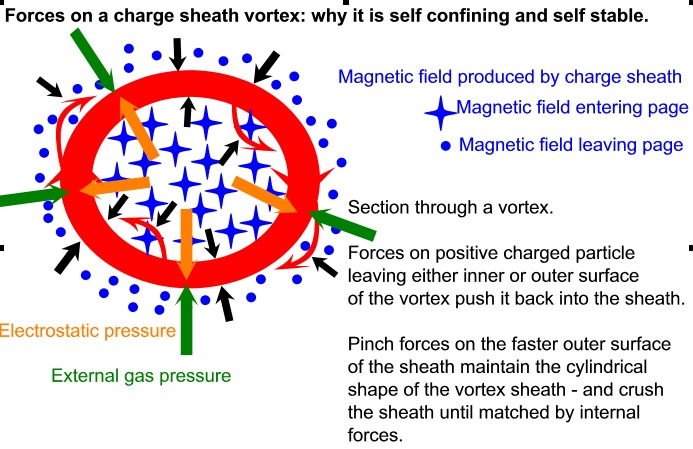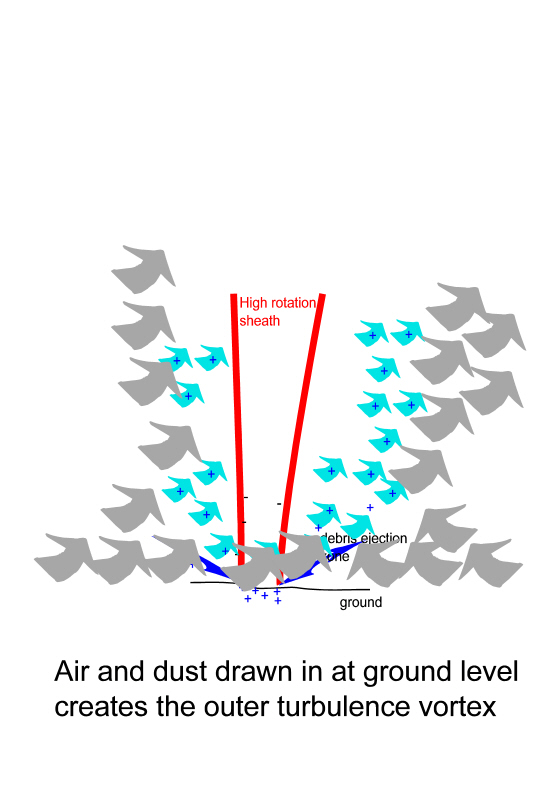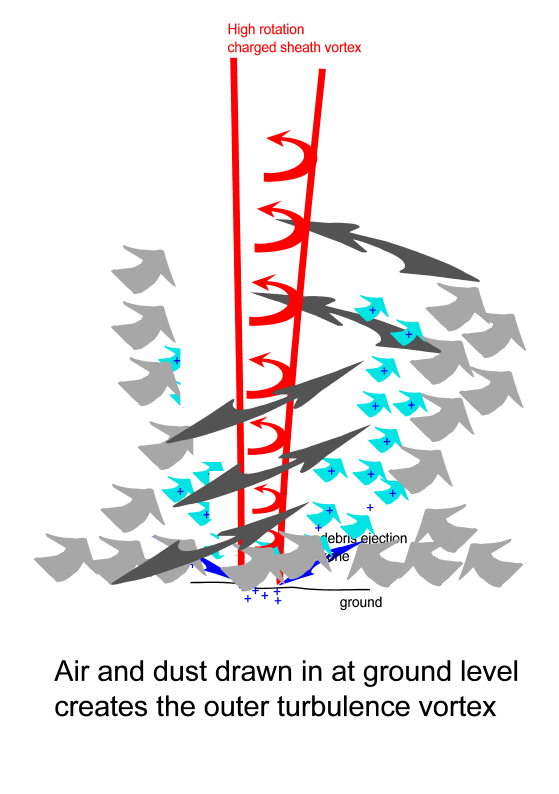- A Self Organised Structure for the Tornado
How useful is this
Don't dismiss this theory on the grounds that the electromagnetic field
produced by a moving charge is many times smaller than the electrostatic
forces produced by the same charge. Or calculate on the basis of large point
charges. In a gas, the forces apply to a single molecule or a single electron.
There is no aggregation of charge. Read right through, and assess whether
this theory accounts for the points made by observation of tornadoes.
This theory proposes that the tornado forms from the rotation (round
a vertical axis) of a large volume of cloud which carries an electrical
charge.
Such rotation has been measured in many clouds using doplar radar, and the
rotation of clouds prior to the formation of tornadoes has been filmed.
The electrons that give such a cloud a charge are attached to molecules
of N2 or O2 or water vapour. Only a small proprtion of these air molecules
will carry this excess charge. The majority of molecules will be electrically
neutral.
The molecules in a cloud of gas are moving randomly in all directions in
proportion to their temperature, and near collisions between these molecules
give rise to the gas pressure. The charge particles will similarly be carried
in all directions.
In a rotating cloud, there is an overall flow of these molecules in the
direction of rotation, which is the net flow of this random movement of molecules
in the direction of rotating.
We cannot therefore consider the effects produced by these molecules, as
being molecules moving in parallel - because they are not. We can compare
the net result of these molecules random movements against the net results
of the random movements of all the molecules in the cloud.
This theory is based on the following forces:
Each moving charge will create an electromagnetic field round itself.
The sum of the magnetic field produced by the random movements in the direction
of rotation will produce a solenoidal magnetic field round the vertical
axis of rotation.
The electrostatic charge on each charged molecule will repel others, but
in a large charge cloud this will be approximately the same in all directions.
Electrostatic charge between charged molecules can cause increased separation
of these molecules - an electrostatic pressure - that opposes the surrounding
air pressure. This electrostatic pressure causes a slight decrease in density
in the the charge cloud, but it is otherwise stable. The electrostatic pressure
can be balanced by the air pressure, so that the charge cloud does not fly
apart under mutual repulsion of charge.
In a cloud that has an electrostatic gradient, neutral molecules form dipoles
that experience a force that attracts them towards a point of increased
charge.
Development of these forces within a rotating charged cloud.
- Assume the cloud is initially rotating round a vertical axis, and the excess charge is uniformly distributed.
- The electrostatic pressure is the same in all directions, and has not net force on a charged particle.
- The net flow of the charged particles round the vertical axis will produce a small electromagnetic field shaped as a solenoid round the vertical axis.
- As charged molecules follow their random paths in this circulation, there will be a small net force inwards as they move through the electromagnetic field of the solenoid.
- This small net force inwards will result in a small increase in pressure inwards.
- As molecules collide in this circulation, there will be a small inwards force on the charge, pushing the charge inwards.
- These small forces will result in the transfer inwards of a small amount of rotational energy from the kinetic movement of these molecules. This will be observed as a small acceleration of the rotational velocity of the charge cloud towards the center of rotation, through conservation of rotational energy.
Continued development of the rotating charge cloud.
- Charge is now slightly greater towards the centre of rotation.
- Electrostatic pressure is now greater towards the centre of rotation, but as these molecules move further apart through electrostatic pressure, the kinetic component of air pressure reduces to match: The net pressure forces on these molecules remains the same.
- The increased net flow of the charged particles round the vertical axis produces an increased electromagnetic field.
- The increased density of charged particles in the faster circulation produces an increased electromagnetic field.
- Two new forces now come into play:
- The aerodynamic forces at work in a faster moving airflow reduce its internal pressure.
- The increase in charge towards the centre of rotation now results in an electrostatic charge gradient from the centre outwards. The neutral molecules in the rotating cloud now form dipoles that experience a net attraction towards the center. These now contribute to the inwards force and the transfer of rotational energy inwards.
- Positive feedback results in increased electromagnetic fields, increased
charge transfer inwards, increased rotational velocity of a smaller core.
- The maximum charge density that can be sustained by this mechanism is when the electrostatic pressure in the rotating vortex is matched by the external air pressure.
- The vortex sheath can still grow in thickness as more charge molecules are added to it. Electrostatic pressure will be reduced in a fast moving charge cloud for the same reason that air pressure is reduced in a fast moving air flow - the same forces are involved.
- The maximum charge gradient in the charge cloud that can be sustained is when the electromagnetic force pushing the charge inwards is matched by the electrostatic force pushing the charge outwards.
- This central vortex is still too weak, and lacks the coherency that I think we are observing in the tornado's vortex tube.
- I am proposing that another mechanism is involved as the electron density increases in the rotating centre of the cloud.
- As charged molecules collide in the rotating airstream some electrons are knocked free, and in the magnetic field of the solenoid of the rotating cloud, these electrons will continue to travel in the same direction before colliding with another air molecule.
- These free electrons travel briefly at speeds closer to 1000000 m/s. A cascade of free electrons produces an electromagnetic field that contributes to the soleoidal field of the vortex tube and intensifies it.
- The electromagnetic field now produced by the rotating sheath is now sufficient to hold all the electrons against the repulsion that would be expected if the average rotational speed of the electrons was the same as the airflow.
- The vortex tube is maintained by the inflow of electrons from the rotating charged cloud above
The vortex tube.
- The vortex tube created should be the same charge as the charge cloud that produced it.
- It should be rotating in the same direction as the charge cloud.
- The high charge in the vortex tube is held in place - from flying outwards by the electromagnetic field it creates, and air pressure, and hydrodynamic forces which create a stable vortex.
- The centre of the tube is kept open:
- because the electromagnetic field produced by opposite walls of the tube oppose each other, this prevents the tube from collapsing.
- centrifugal forces.

This theory has proposed that the tornado tube is highly electrostatically
charged, and the opposing aerodynamic forces, electrostatic forces and
electromagnetic field, together produce a vortex tube with considerable shear
strength. The charged vortex sheath bites into the ground rather like a hole
cutter. A tubular narrow blade rotating at high speed moving over the
ground surface.
 The result is a turbulence vortex of dust and air rising, surrounding
the charged sheath vortex of the tornado at its centre.
The result is a turbulence vortex of dust and air rising, surrounding
the charged sheath vortex of the tornado at its centre.
The Anatomy of a Large Tornado
When we watch a large tornado, what we see is the rising
turbulence vortex of dust and debris, but at its core it is powered by
a charged sheath vortex of extreme ferocity and strength. From http://www.kwtv.com/wx/wxcenter.htm
is tornado2.mov(389K)
A or tornado2.mov
from cache A huge tornado, but most of what we can see are hanging plumes
of ejected material, in a gently rising and gently rotating air stream.
The violence of the charged sheath at the core is not visible.

You are welcome to join the discussion, but please note that any claims you make for or against these theories should be backed by scientific reasoning that can be developed from first principles.
Copyright Peter Thomson 2012-March-16
